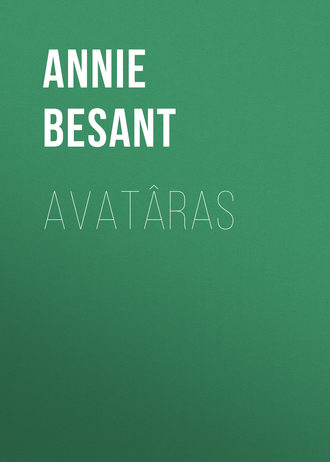 полная версия
полная версияAvatâras
Nobly he did the work, thoroughly he discharged his duty. It is said that even sages are confused about Dharma, and truly it is subtle and hard to grasp in its entirety, though the fragment the plain man sees be simple enough. His Dharma was the Dharma of a Râkshasa, to lead the whole forces of evil against One whom in his inner soul, then clouded, he loved. When Shrî Râma came, when He was wandering in the forest, how could he sting Him into leaving the life of His life, His beloved Sîtâ, and into coming out into the world to do His work? By taking away from Him the one thing to which He clung, by taking away from Him the wife whom He loved as His very Self, by placing her in the spot where all the forces of evil were gathered together, so making one head for destruction, which the arrow of Shrî Râma might destroy. Then the mighty battle, then the struggle with all the forces of his great nature, that the law might be obeyed to the uttermost, duly fulfilled to the last grain, the debt paid that was owed; and then – ah then! the shaft of the Beloved, then the arrow of Shrî Râma that struck off the head from the seeming enemy, from the real devotee. And from the corpse of the Râkshasa that fell upon the field near Lanka, the devotee went up to Goloka8 to sit at the feet of the Beloved, and rest for awhile till the third incarnation had to be lived out.
Such then are some of the reasons by, the ways in which the coming of the Avatâra is brought about. And my last word to you, my brothers, to-day is but a sentence, in order to avoid the possibility of a mistake to which our diving into these depths of thought may possibly give rise. Remember that though all powers are His, all forces His, Râkshasa as much as Deva, Asura as much as Sura; remember that for your evolution you must be on the side of good, and struggle to the utmost against evil. Do not let the thoughts I have put lead you into a bog, into a pit of hell, in which you may for the time perish, that because evil is relative, because it exists by the one will, because Râkshasa is His as much as Deva, therefore you shall go on their side and walk along their path. It is not so. If you yield to ambition, if you yield to pride, if you set yourselves against the will of I´shvara, if you struggle for the separated self, if in yourselves now you identify yourself with the past in which you have dwelt instead of with the future towards which you should be directing your steps, then, if your Karma be at a certain stage, you pass into the ranks of those who work as enemies, because you have chosen that fate for yourself, at the promptings of the lower nature. Then with bitter inner pain – even if with complete submission – accepting the Karma, but with profound sorrow, you shall have to work out your own will against the will of the Beloved, and feel the anguish of the rending that separates the inner from the outer life. The will of I´shvara for you is evolution; these forces are made to help your evolution —but only if you strive against them. If you yield to them, then they carry you away. You do not then call out your own strength, but only strengthen them. Therefore, O Arjuna, stand up and fight. Do not be supine; do not yield yourself to the forces; they are there to call out your energies by opposition and you must not sink down on the floor of the chariot. And my last word is the word of Shrî Kṛiṣhṇa to Arjuna: "Take up your bow, stand up and fight."
Third Lecture
The subject this morning, my brothers, is in some ways an easy and in other ways a difficult one; easy, inasmuch as the stories of the Avatâras can be readily told and readily grasped; difficult, inasmuch as the meaning that underlies these manifestations may possibly be in some ways unfamiliar, may not have been thoroughly thought out by individual hearers. And I must begin with a general word as to these special Avatâras. You may remember that I said that the whole universe may be regarded as the Avatâra of the Supreme, the Self-revelation of I´shvara. But we are not dealing with that general Self-revelation; nor are we even considering the very many revelations that have taken place from time to time, marked out by special characteristics; for we have seen by referring to one or two of the old writings that many lists are given of the comings of the Lord, and we are to-day concerned with only some of those, those that are accepted specially as Avatâras.
Now on one point I confess myself puzzled at the outset, and I do not know whether in your exoteric literature light is thrown upon the point as to how these ten were singled out, who was the person who chose them out of a longer list, on what authority that list was proclaimed. On that point I must simply state the question, leaving it unanswered. It may be a matter familiar to those who have made researches into the exoteric literature. It is not a point of quite sufficient importance for the moment to spend on it time and trouble, in what we may call the occult way of research. I leave that then aside, for there is one reason why some of these stand out in a way which is clear and definite. They mark stages in the evolution of the world. They mark new departures in the growth of the developing life, and whether it was that fact which underlay the exoteric choice I am unable to say; but certainly that fact by itself is sufficient to justify the special distinction which is made.
There is one other general point to consider. Accounts of these Avatâras are found in the Purâṇas; allusions to them, to one or other of them, are found in other of the ancient writings, but the moment you come to very much detail you must turn to the Paurâṇic accounts; as you are aware, sages, in giving those Purâṇas, very often described things as they are seen on the higher planes, giving the description of the underlying truth of facts and events; you have appearances described which sound very strange in the lower world; you have facts asserted which raise very much of challenge in modern days. When you read in the Purâṇas of strange forms and marvellous appearances, when you read accounts of creatures that seem unlike anything that you have ever heard of or dreamed of elsewhere, the modern mind, with its somewhat narrow limitations, is apt to revolt against the accounts that are given; the modern mind, trained within the limits of the science of observation, is necessarily circumscribed within those limits and those limits are of an exceedingly narrow description; they are limits which belong only to modern time, modern to men, in the true sense of the word, though geological researches stretch of course far back into what we call in this nineteenth century the night of time. But you must remember that the moment geology goes beyond the historic period, which is a mere moment in the history of the world, it has more of guesses than of facts, more of theories than of proofs. If you take half a dozen modern geologists and ask each of them in turn for the date of the period of which records remain in the small number of fossils collected, you will find that almost every man gives a different date, and that they deal with differences of millions of years as though they were only seconds or minutes of ours. So that you will have to remember in what science can tell you of the world, however accurate it may be within its limits, that these limits are exceedingly narrow, narrow I mean when measured by the sight that goes back kalpa after kalpa, and that knows that the mind of the Supreme is not limited to the manifestations of a few hundred thousands of years, but goes back million after million, hundreds of millions after hundreds of millions, and that the varieties of form, the enormous differences of types, the marvellous kinds of creatures which have come out of that creative imagination, transcend in actuality all that man's mind can dream of, and that the very wildest images that man can make fail far short of the realities that actually existed in the past kalpas through which the universe has gone. That word of warning is necessary, and also the warning that on the higher planes things look very different from what they look down here. You have here a reflection only of part of those higher forms of existence. Space there has more dimensions than it has on the physical plane, and each dimension of space adds a new fundamental variety to form; if to illustrate this I may use a simile I have often used, it may perhaps convey to you a little idea of what I mean. Two similes I will take each throwing a little light on a very difficult subject. Suppose that a picture is presented to you of a solid form; the picture, being made by pen or pencil on a sheet of paper, must show on the sheet, which is practically of two dimensions – a plane surface – a three dimensional form; so that if you want to represent a solid object, a vase, you must draw it flat, and you can only represent the solidity of that vase by resorting to certain devices of light and shade, to the artificial device which is called perspective, in order to make an illusory semblance of the third dimension. There on the plane surface you get a solid appearance, and the eye is deceived into thinking it sees a solid when really it is looking at a flat surface. Now as a matter of fact if you show a picture to a savage, an undeveloped savage, or to a very young child, they will not see a solid but only a flat. They will not recognise the picture as being the picture of a solid object they have seen in the world round them; they will not see that that artificial representation is meant to show a familiar solid, and it passes by them without making any impression on the mind; only the education of the eye enables you to see on a flat surface the picture of a solid form. Now, by an effort of the imagination, can you think of a solid as being the representation of a form in one dimension more, shown by a kind of perspective? Then you may get a vague idea of what is meant when we speak of a further dimension in space. As the picture is to the vase, so is the vase to a higher object of which that vase itself is a reflection. So again if you think, say, of the lotus flower I spoke of yesterday, as having just the tips of its leaves above water, each tip would appear as a separate object. If you know the whole you know that they are all parts of one object; but coming over the surface of the water you will see tips only, one for each leaf of the seven-leaved lotus. So is every globe in space an apparently separate object, while in reality it is not separated at all, but part of a whole that exists in a space of more dimensions; and the separateness is mere illusion due to the limitations of our faculties.
Now I have made this introduction in order to show you that when you read the Purâṇas you consistently get the fact on the higher plane described in terms of the lower, with the result that it seems unintelligible, seems incomprehensible; then you have what is called an allegory, that is, a reality which looks like a fancy down here, but is a deeper truth than the illusion of physical matter, and is nearer to the reality of things than the things which you call objective and real. If you follow that line of thought at all you will read the Purâṇas with more intelligence and certainly with more reverence than some of the modern Hindus are apt to show in the reading, and you will begin to understand that when another vision is opened one sees things differently from the way that one sees them on the physical plane, and that that which seems impossible on the physical is what is really seen when you pass beyond the physical limitations.
From the Purâṇas then the stories come.
Let me take the first three Avatâras apart from the remainder, for a reason that you will readily understand as we go through them. We take the Avatâra which is spoken of as that of Matsya or the fish; that which is spoken of as that of Kûrma or the tortoise; that which is spoken of as that of Vârâha, or the boar. Three animal forms; how strange! thinks the modern graduate. How strange that the Supreme should take the forms of these lower animals, a fish, a tortoise, a boar! What childish folly! "The babbling of a race in its infancy," it is said by the pandits of the Western world. Do not be so sure. Why this wonderful conceit as to the human form? Why should you and I be the only worthy vessels of the Deity that have come out of the illimitable Mind in the course of ages? What is there in this particular shape of head, arms, and trunk which shall make it the only worthy vessel to serve as a manifestation of the supreme I´shvara? I know of nothing so wonderful in the mere outer form that should make that shape alone worthy to represent some of the aspects of the Highest. And may it not be that from His standpoint those great differences that we see between ourselves and those which we call the lower forms of life may be almost imperceptible, since He transcends them all? A little child sees an immense difference between himself of perhaps two and a half feet high and a baby only a foot and a half high, and thinks himself a man compared with that tiny form rolling on the ground and unable to walk. But to the grown man there is not so much difference between the length of the two, and one seems very much like the other. While we are very small we see great differences between ourselves and others; but on the mountain top the hovel and the palace do not differ so very much in height. They all look like ant-hills, very much of the same size. And so from the standpoint of I´shvara, in the vast hierarchies from the mineral to the loftiest Deva, the distinctions are but as ant-hills in comparison with Himself, and one form or another is equally worthy, so that it suits His purpose, and manifests His will.
Now for the Matsya Avatâra; the story you will all know: when the great Manu, Vaivasvata Manu, the Root Manu, as we call Him – that is, a Manu not of one race only, but of a whole vast round of kosmic evolution, presiding over the seven globes that are linked for the evolution of the world – that mighty Manu, sitting one day immersed in contemplation, sees a tiny fish gasping for water; and moved by compassion, as all great ones are, He takes up the little fish and puts it in a bowl, and the fish grows till it fills the bowl; and He placed it in a water vessel and it grew to the size of the vessel; then He took it out of that vessel and put it into a bigger one; afterwards into a tank, a pond, a river, the sea, and still the marvellous fish grew and grew and grew. The time came when a vast change was impending; one of those changes called a minor pralaya, and it was necessary that the seeds of life should be carried over that pralaya to the next manvantara. That would be a minor pralaya and a minor manvantara. What does that mean? It means a passage of the seeds of life from one globe to another; from what a we call the globe preceding our own to our own earth. It is the function of the Root Manu, with the help and the guidance of the planetary Logos, to transfer the seeds of life from one globe to the next, so as to plant them in a new soil where further growth is possible. As waters rose, waters of matter submerging the globe which was passing into pralaya, an ark, a vessel appeared; into this vessel stepped the great Ṛishi with others, and the seeds of life were carried by Them, and as They go forth upon the waters a mighty fish appears and to the horn of that fish the vessel is fastened by a rope, and it conveys the whole safely to the solid ground where the Manu rebegins His work. A story! yes, but a story that tells a truth; for looking at it as it takes place in the history of the world, we see the vast surging ocean of matter, we see the Root Manu and the great Initiates with Him gathering up the seeds of life from the world whose work is over, carrying them under the guidance and with the help of the planetary Viṣhṇu to the new globe where new impulse is to be given to the life; and the reason why the fish form was chosen was simply because in the building up again of the world, it was at first covered with water, and only that form of life was originally possible, so far as denser physical life was concerned.
You have in that first stage what the geologists call the Silurian Age, the age of fishes, when the great divine manifestation was of all these forms of life. The Purâṇa rightly starts in the previous Kalpa, rightly starts the manifestations with the manifestation in the form of the fish. Not so very ridiculous after all, you see, when read by knowledge instead of by ignorance; a truth, as the Purâṇas are full of truth, if they were only read with intelligence and not with prejudice.
But some of you may say that there is confusion about these first Avatâras; in several accounts we find that the Boar stands the first; that is true, but the key of it is this; the Boar Avatâra initiated that evolution which was followed unbrokenly by the human; whereas the other two bring in great stages, each of which is regarded as a separate kalpa; and if you look into the Viṣhṇu Purâṇa you will find there the key; for when that begins to relate the incarnation of the Boar, there is just a sentence thrown in, that the Matsya and Kûrma Avatâras belong to previous kalpas.
Now if we take the theosophical nomenclature, we find each of these kalpas covers what we call a Root Race, and you may remember that the first Root Race of humanity had not human form at all but was simply a floating mass able to live in the waters which then covered the earth, and only showing the ordinary protoplasmic motions connected with such a type of life and possible at that stage of its evolution. It was a seed of form rather than a form itself; it was the seed planted by the Manu in the waters of the earth, that out of that humanity might evolve. But the general course of physical evolution passed through the stage of the fish; and geology there gives a true fact, though it does not understand, naturally, the hidden meaning; while the Purâṇa gives you the reality of the manifestation, and the deeper truth that underlies the stages of the evolving world.
Then we find, tracing it onward, that this great age passes, and the world begins to rise out of the waters. How then shall types be brought forth in order that evolution may go on? The next great type is to be fitted either for land or for water; for the next stage of the earth shows the waters draining gradually away, and the land appearing, and the creatures that are the marked characteristic of the age must exist partially on land and partially in water. Here again there must be manifestation of the type of life, this time of what we call the reptile type; the tortoise is chosen as the typical creature, and while the tortoise typifies the type to be evolved, reptiles, amphibious creatures of every description, swarm over the earth, becoming more and more land-like in their character as the proportion of land to water increases. There is meanwhile going on, in the "imperishable sacred land," a preparation for further evolution. There is one part of the globe that changes not, that from the beginning has been, and will last while the globe is lasting; it is called the "imperishable land." And there the great Ṛishis gather, and thence they ever come forth for the helping of man; that is the imperishable sacred land, sometimes called the "sacred pole of the earth." Pole itself exists not on the physical plane but on the higher, and its reflection coming downward makes, as it were, one spot which never changes, but is ever guarded from the tread of ordinary men. There took place a most instructive phenomenon. The type of the evolution then preceding, the Tortoise, the Logos in that form, makes Himself the base of the revolving axis of evolution. That is typified by Mandâra, the mountain which, placed on the tortoise, is made to revolve by the hosts of Suras and Asuras, one pulling at the head of the serpent, and the other at the tail – the positive and negative forces that I spoke of yesterday. So the churning begins in matter, evolving types of life. The type is ever evolved before the lower manifestation, the type appears before the copies of it are born in the lower world. And how often have the students of the great Teachers themselves seen the very thing occur; the churning of the waters of matter giving forth all the types of the many sorts and species that are generated in the lower world; these are the archetypes, as we call them, of classes and creatures, always produced in preparation for the forward stretch of evolution. There came forth one by one the archetypes, the elephant, the horse, the woman, and so on, one after another, showing the track along which evolution was to go. And first of all, Amṛita, nectar of immortality, comes forth, symbol of the one life which passes through every form – and that life appears above the waters the taking of which is necessary in order that every form may live.
We cannot delay on details; I can only trace hastily the outline, showing you how real is the truth that underlies the story, and as that gradually goes on and the types are ready, there comes the whelming of the world under the waters, and the great continents vanish for a time.
Then comes the third Avatâra, the Vârâha. No earth is to be seen; the waters of the flood have overwhelmed it. The types that are to be produced on earth are waiting in the higher region for place on which to manifest. How shall the earth be brought up from the waters which have overwhelmed it? Now once again the great Helper is needed, the God, the Protector of Evolution. Then in the form of a mighty Boar, whose form filled the heaven, plunging down into the waters that He alone could separate, the Great One descends. He brings up the earth from the lower region where it was lying awaiting His coming; and the land rises up again from below the surface of the flood, and the vast Lemurian continent is the earth of that far-off age. Here science has a word to say, rightly enough, that on the Lemurian continent were developed many types of life, and there the mammals first made their appearance. Quite so; that was exactly what the sages taught thousands upon thousands of years ago; that when the Boar, the great type of the mammal, plunged into the waters to bring up the earth, then was started the mammalian evolution, and the continent thus rescued from the waters was crowded with the forms of the mammalian kingdom. Just as the Fish had typified the Silurian epoch, just as the Tortoise had started on its way the great amphibian evolution, so did the Boar, that typical mammal, start the mammalian evolution, and we come to the Lemurian continent with its wonderful variety of forms of mammalian life. Not so very ignorant after all, you see, the ancient writings! For men are only re-discovering to-day what has been in the hands of the followers of the Ṛishis for thousands, tens of thousands of years.
Then we come to a strange incarnation on this Lemurian continent: frightful conflicts existed; we are nearing what in the theosophical nomenclature is the middle of the third Race, and man as man will shortly appear with all the characteristics of his nature. He is not yet quite come to birth; strange forms are seen, half human and half animal, wholly monstrous; terrible struggles arise between these monstrous forms born from the slime as it is said – from the remains of former creations – and the newer and higher life in which the future evolution is enshrined. These forms are represented in the Purâṇas as those of the race of Daityas, who ruled the earth, who struggled against the Deva manifestations, who conquered the Devas from time to time, who subjected them, who ruled over earth and heaven alike, bringing every thing under their sway. You may read in the splendid stanzas of the Book of Dzyan, as given us by H. P. B., hints of that mighty struggle of which the Purâṇas are so full, a struggle which was as real as any struggle of later days, an absolute historical fact that many of us have seen. We are instructed over and over again of a frightful conflict of forms, the forms of the past, monstrous in their strength and in their outline, against whom the Sons of Light were battling, against whom the great Lords of the Flame came down. One of these conflicts, the greatest of all, is given in the story of the Avatâra known as that of Narasimha – the Man-Lion. You know the story; what Hindu does not know the story of Prahlâda? In him we have typified the dawning spirituality which is to show in the higher races of Daityas as they pass on into definite human evolution, and their form gives way that sexual man may be born. I need not dwell on that familiar story of the devotee of Viṣhṇu; how his Daitya father strove to kill him because the name of Hari was ever on his lips; how he strove to slay him, with a sword, and the sword fell broken from the neck of the child; how then he tried to poison him, and Viṣhṇu appeared and ate first of the poisoned rice, so that the boy might eat it with the name of Hari on his lips; how his father strove to slay him by the furious elephant, by the fang of the serpent, by throwing him over a precipice, and by crushing him under a stone. But ever the cry of "Hari, Hari," brought deliverance, for in the elephant, in the fang of the serpent, in the precipice, and in the stone, Hari was ever present, and his devotee was safe in that presence: how finally when the father, challenging the omnipresence of the Deity, pointed to the stone pillar and said in mocking language: "Is your Hari also in the pillar?" "Hari, Hari," cried the boy, and the pillar burst asunder, and the mighty form came forth and slew the Daitya that doubted, in order that he might learn the omnipresence of the Supreme. A story? facts, not fiction; truth, not imagination; and if you could look back to the time of those struggles, there would seem to you nothing strange or abnormal in the story; for you would see it repeated with less vividness in the smaller struggles where the Sons of the Fire were purging and redeeming the earth, in order that the later human evolution might take place.








